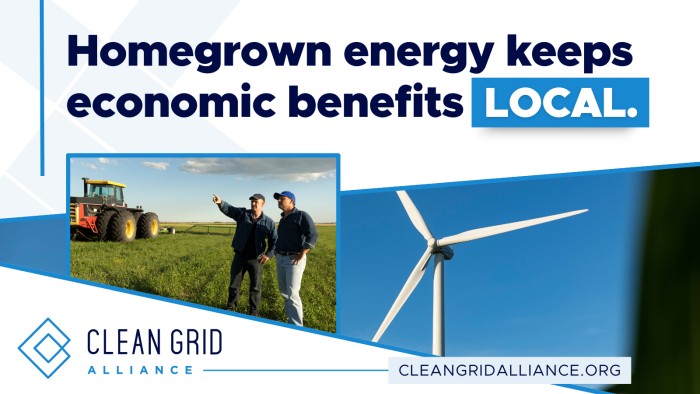3 Ways Rural Communities Benefit from Renewable Energy Development
 | Molly Vagle, Communications Associate, Siting |

 | Molly Vagle, Communications Associate, Siting |
As the nation transitions to more clean energy generation sources, rural communities are receiving tangible benefits from hosting those projects in their communities. The creation of new jobs, new tax revenue and income streams demonstrate that renewable energy projects make economic sense, while providing an opportunity for younger generations to stay in their communities. And that is a benefit for all rural communities. What's good for the goose is good for the gander. Read more to find out how!
1. Jobs for Young People
Many small towns struggle to keep young people in their communities because of the lack of economic development, community amenities and above all, job opportunities. It is widely known that cities attract younger generations and rural folks because of better job opportunities, career prospects, and higher wages. This contributes to population decline in rural communities, and something called the rural-urban migration. However, renewable energy development in rural areas may help resolve or at least help with the issue.
That's because renewable energy projects offer full-time, family supporting jobs within the community. Look at Indiana for example. "The [renewable energy] industry has already employed about 12,000 workers," said Economist and President of Strategic Economic Research, David Loomis. That is 12,000 Hoosiers receiving local, well-paid jobs that may allow them to stay in their communities, and not need to seek jobs and opportunities elsewhere.
The renewable energy industry in total is an important job creator and employs over 460,000 Americans.
2. Increased Tax Base
In addition to creating American jobs, renewable energy projects pay taxes to the local jurisdictions in which they are located. This provides a new source of tax revenue for local communities, which they may choose to use for essential purchases and upgrades like education support and upgrades, road and bridges infrastructure improvements, police, fire, and health services upgrades, to name a few. By increasing the tax base of the county, the tax burden on residents can be relieved, a significant benefit for everyone. In addition, because these projects cannot move away from the area, like other forms of development can, this form of tax revenue is very steady, and much more predictable.
Let's look at a few examples of how communities around the Midwest have used tax revenue from renewable energy developments. Iowa ranks first in the nation for its share of electricity produced by wind, solar, and energy storage power plants.
“Nearly 300 wind turbines generate not just power, but more than $172 million for the local economy. ... That revenue generated enough money to be approximately 17% to 20% of the county's budget.
said Former Worth County Supervisor, Merlin Bartz
Schools are often a big beneficiary of this tax revenue. In Michigan, three school districts in Isabella County are asking for $35.4 million through their bond proposal to make needed upgrades. However, none of the schools will have to raise taxes in their communities because of the taxes on the wind farms in the area.
Story County, Iowa, has 137 wind turbines, and has used their wind tax revenue to fund special projects. These include transportation infrastructure, public land improvements, main street revitalization, communication infrastructure, and housing development.
Iowa has received $25 billion in capital investments from wind, solar, and energy storage projects in the state, along with $61.5 million annually in property, state, and local taxes from renewable energy projects.
Subscribe to our newsletter for the latest on energy & our work
Michigan has received $8 billion in capital investments from wind, solar, and energy storage projects in the state, along with $65.5 million annually in property, state, and local taxes from renewable energy projects. In total in the United States, there has been $499 billion in capital investments from renewable energy, and $1.7 billion annually in taxes.
3. New Income Streams to Landowners
Last, but certainly not least, is the new income stream that flows to landowners and farmers who host non-permanent renewable energy projects on their land. Renewable energy needs to be sited on suitable land. There are lots of factors that go into determining whether a property is suitable for development, but that is a topic for another day. Willing landowners are compensated with land-lease payments in exchange for allowing a wind turbine or solar array to be sited on a portion of their land during the project lifecycle. These lease payments provide long-term, drought-proof, stable sources of revenue for those who host renewable energy projects.
Farmers and other landowners may have a variety of reasons for choosing to lease their land for non-permanent renewable energy development. They may want a passive source of income to save their family farm. According to the USDA, 96 percent of family farms depend on non-farm income to survive. According to the Strategic Economic Research "Economic Impact Analysis for Lotus Wind Project" Illinois report, "Lease payments made to landowners provide a reliable source of long-term income which offsets the fluctuating prices received from crops or the impact of weather events on production. Landowners then have additional funds to make purchases in the local economy and elsewhere."
Further, according to a 2014 study by Dr. Sarah Mills from the Gerald R. Ford School of Public Policy at the University of Michigan, landowners with wind turbines on their property invest twice as much money into their farms for home improvements, outbuildings, and equipment, then landowners without wind turbines.
This income is additional to any farming or other income that was previously made off the land. Renewable energy projects, especially wind turbines, have a small physical footprint so the land can be used for both hosting turbines and for ranching or crop farming, allowing farmers to enjoy both sources of revenue at the same time.
In Illinois, renewable energy projects have provided $62.3 million annually in land-lease payments to farmers, ranchers, and private landowners. In total, landowners in the United States have received upwards of $1.8 billion annually for drought-proof lease payments.
Renewable energy projects make economic sense for rural communities. They bring jobs, increase tax revenue, which benefits the entire area, and provide extra income directly to landowners. Renewable energy allows rural communities to be less reliant on big cities and corporations for jobs and brings the opportunities back home. Support renewable energy and subscribe to stay informed!